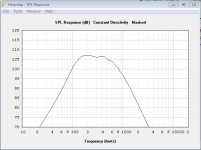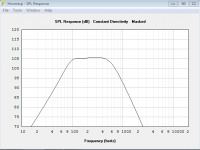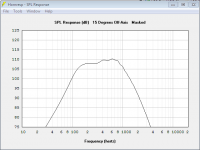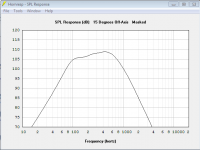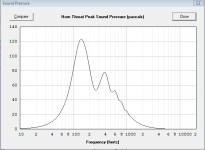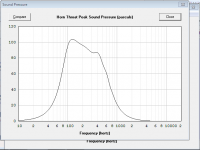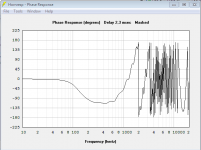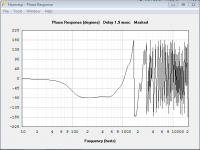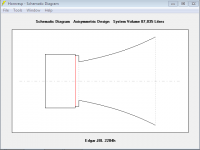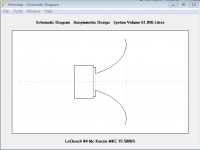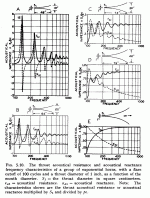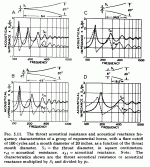It provides an approximation of frequency response, not distortion products that occur, particularly when the driver becomes un-loaded by a short horn.
[Fc], horn cutoff frequency, determines m = 2*pi()*fc/c the flare coefficient.
In theory, [Fc] represents the frequency below which the horn will not radiate acoustic energy.
System resonant frequency is normally set higher than [Fc]. A longer horn (and enclosed air column), brings this down with additional mass loading of the driver.
[Ls] stands for the length of the curve that forms the horn boundary. It includes the length of the curled back lips as well.
Only intent was unclear here. The question is a rhetorical one.
Regards,
WHG
Thanks! Nice to get some theory behind it all.
That is what I am trying to understand, and of course the most important thing of all...actually to build some horns 🙂
Good Luck
Acoustics is a challenging but rewarding hobby. Horn building requires patients and persistence far beyond that needed for a simple box build. Before you start, try to make all mistakes on paper. It is a measure twice and cut once thing.
Regards,
WHG
Thanks! Nice to get some theory behind it all.
That is what I am trying to understand, and of course the most important thing of all...actually to build some horns 🙂
Acoustics is a challenging but rewarding hobby. Horn building requires patients and persistence far beyond that needed for a simple box build. Before you start, try to make all mistakes on paper. It is a measure twice and cut once thing.
Regards,
WHG
Thanks...good advice!
I will continue to simulate before building, and will of course appreciate your expertice/advice, if you see something totally wrong with the design/simulation.
I will continue to simulate before building, and will of course appreciate your expertice/advice, if you see something totally wrong with the design/simulation.
I have summed up some points to consider.
NEODan has been very nice and have come up with some interesting designs to design a rather short LeCleach horn. I will post some sims of the latest tomorrow.
So what to consider?
A longer horn because of the danger in getting horn-honk and lower mouth reflectance.
It is mentioned that in a LeCleach horn the length is “edge traced” along the horns profile. I have not yet understood this?
Whgeiger also states that the axial length is of importance in keeping the (Fl) to its optimum and that the aircolumn bounded by the horn is a principal determinant of the low frequency of the horn.
Whgeiger also recommends that if my high pass filter is to be set by 80hz@24db, the (fc) should be near 60hz. This could be done by reducing the throat diameter.
I am working on the formulas given by Whgeiger, but I have to admit that I am better in understanding it explained in words at this given time. I have been plotting a lot of different horns during the last weeks in Hornresp, downloaded several help-threads, and still learning.
When working around NEODan’s sims I notice that the cut-off frequency is near 200hz. Still they simulate the lowest SPL respons in Hornresp compared to Hypex, Tractrix, Conical. I don’t quite get this, as stated earlier.
Why can a LeCleach that has a 182hz cut off load down to 80hz, when everything I have read uptil now says that it should be XO’ed an octave below? Please bear with me Dan ☺
None of the others sims as well either, regarding a smooth SPL respons, and when NEODan did a comparison between my Hypex in the first post and his LeCleach his sim made the driver work more and moving a lot more air.
Is NEODan on to something new here? I mean, who wouldn’t want to have a shorter horn regarding space?
No doubt that NEODan has used a lot of time learning Hornresp.
NEODan thinks that the Fta 180 is not well suited for a horn used near boundarys, because the horn must provide a higher impedance to achieve more horn loading. He would probably not design a round horn that near the floor with a full roll-back. He would have a flat bottom.
I, on the other hand, want to have a round horn at the bottom. Why? Well, even “the cat” has it, so it can’t be that bad 😉 It also has to do with aestheics for me.
On the other hand, maybe a LeCleach with a full roll-back is not the optimal solution? Could we construct a LeCleach with less than 180%, raise it a little bit from the floor, and have, the more or less same response? We can of course talk about throat reflection all night long, but in the end, if it’s all theory…what the hell…I want to build some horns and enjoy the music ☺
I do think Whgeiger has some interesting points:
“It provides an approximation of frequency response, not distortion products that occur, particularly when the driver becomes un-loaded by a short horn.
Like a hammer, it is a tool that won’t prevent bent nails.”
Note: How can Avantgarde claim that their tractrix load down to 100-150hz, when the horn itself has an axial length of 65cm and a mouth diameter of 95cm? I don’t get it.
Nobody has built these LeCleach horns, and I really wonder how they will work in real life?
So what do I want? I want to start building! I understand that some patience is required, but the world doesn’t go forward by only thinking…
I want the horn to be at least 50cm in axial length. Why? Well, my plan is to use a compression driver to 400-500hz, and that LeCleach horn will be at least 35-40cm. It would be strange if the midhorn was “in front” of the mid/upper bass horn.
I want the diameter to be from 90-95 cm.
Do not misunderstand me, I know there are compromises, and that’s what Audio is all about.
Thanks to NeoDan, Whgeiger and David that has contributed.
NEODan has been very nice and have come up with some interesting designs to design a rather short LeCleach horn. I will post some sims of the latest tomorrow.
So what to consider?
A longer horn because of the danger in getting horn-honk and lower mouth reflectance.
It is mentioned that in a LeCleach horn the length is “edge traced” along the horns profile. I have not yet understood this?
Whgeiger also states that the axial length is of importance in keeping the (Fl) to its optimum and that the aircolumn bounded by the horn is a principal determinant of the low frequency of the horn.
Whgeiger also recommends that if my high pass filter is to be set by 80hz@24db, the (fc) should be near 60hz. This could be done by reducing the throat diameter.
I am working on the formulas given by Whgeiger, but I have to admit that I am better in understanding it explained in words at this given time. I have been plotting a lot of different horns during the last weeks in Hornresp, downloaded several help-threads, and still learning.
When working around NEODan’s sims I notice that the cut-off frequency is near 200hz. Still they simulate the lowest SPL respons in Hornresp compared to Hypex, Tractrix, Conical. I don’t quite get this, as stated earlier.
Why can a LeCleach that has a 182hz cut off load down to 80hz, when everything I have read uptil now says that it should be XO’ed an octave below? Please bear with me Dan ☺
None of the others sims as well either, regarding a smooth SPL respons, and when NEODan did a comparison between my Hypex in the first post and his LeCleach his sim made the driver work more and moving a lot more air.
Is NEODan on to something new here? I mean, who wouldn’t want to have a shorter horn regarding space?
No doubt that NEODan has used a lot of time learning Hornresp.
NEODan thinks that the Fta 180 is not well suited for a horn used near boundarys, because the horn must provide a higher impedance to achieve more horn loading. He would probably not design a round horn that near the floor with a full roll-back. He would have a flat bottom.
I, on the other hand, want to have a round horn at the bottom. Why? Well, even “the cat” has it, so it can’t be that bad 😉 It also has to do with aestheics for me.
On the other hand, maybe a LeCleach with a full roll-back is not the optimal solution? Could we construct a LeCleach with less than 180%, raise it a little bit from the floor, and have, the more or less same response? We can of course talk about throat reflection all night long, but in the end, if it’s all theory…what the hell…I want to build some horns and enjoy the music ☺
I do think Whgeiger has some interesting points:
“It provides an approximation of frequency response, not distortion products that occur, particularly when the driver becomes un-loaded by a short horn.
Like a hammer, it is a tool that won’t prevent bent nails.”
Note: How can Avantgarde claim that their tractrix load down to 100-150hz, when the horn itself has an axial length of 65cm and a mouth diameter of 95cm? I don’t get it.
Nobody has built these LeCleach horns, and I really wonder how they will work in real life?
So what do I want? I want to start building! I understand that some patience is required, but the world doesn’t go forward by only thinking…
I want the horn to be at least 50cm in axial length. Why? Well, my plan is to use a compression driver to 400-500hz, and that LeCleach horn will be at least 35-40cm. It would be strange if the midhorn was “in front” of the mid/upper bass horn.
I want the diameter to be from 90-95 cm.
Do not misunderstand me, I know there are compromises, and that’s what Audio is all about.
Thanks to NeoDan, Whgeiger and David that has contributed.
I'd like to add a little for clarification:
From Davids comments here and in the Hornresp thread I concluded that Hornresp WRT simulation of the LeCleach roll-back is a conflicting situation. My current understanding of Hornresp situation of 2pi loading is as if the horn were uniformly loaded/bounded by a surface, the example of that I envision is the horn mouth mounted flush in an imaginary infinite baffle. For obvious reasons this is hardly ever the case for a mid-bass horn and whats worse is the LeCleach roll back is apparently not meant to be loaded in this manner, its native environment is free space where the loading is provided by the horn only. Placing a boundary near a fully formed roll-back will interfere with its ability to behave as modeled. I think the normal placement on or very near a boundary that does not uniformly load circumference of the horn would additionally degrade performance. To what extent the resulting degradation of performance is - well your guess is as good as mine.
The compromise I put in the latter designs was to limit the roll-back to 120 degrees in an attempt to somewhat mitigate the effects.
Also it seems prudent to mention that basically nobody builds real full size 80Hz horns for the domestic environment. Just look at the size of the old Altec theater horns, that's a "real" full size horn, and it's HUGE, and it's also not very deep.
I'm also not so keen on the ideal of squeezing the throat down so small as to produce throat distortion at higher levels. It also increases the load on the cone and will eventually lead to fatigue problems. I'm also not really grasping how a shorter more open horn will have a more reflecting throat, if anything the opposite seems to be the intuitive assumption. Someone enlighten me please 😱
It's common in pro sound to design for an array of subs to achieve the desired mouth area. Imagine a woofer in a tapped horn running on >1kw program for hours on end and being able to reach in and feel the motor structure is barely even above ambient temp. Your array is >30% efficient across most of the pass band and the ground under your feet is moving to the beat. 😎😎😎
AFIK the spec Dolby or THX for the speaker to be used with the 80Hz crossover is -3dB @ 80Hz and the bass management adds another -3dB with the crossover's transfer function.
My mentioning of personally planning to build a horn with a flat bottom was more of an admission than a strict recommendation. My thoughts were that I would have more control of the directivity pattern above the cutoff by designing in an upward tilt and adjusting the horizontal wall angles of the horn to better suit the desired coverage.
You seem to have an existing horn-loaded system, can we simulate the mid-bass horns you have for comparison?
Maybe the others will chime in to add or correct. 🙂
I would like some clarification on the importance of 1/4 wave pathlength vs mouth size.
From Davids comments here and in the Hornresp thread I concluded that Hornresp WRT simulation of the LeCleach roll-back is a conflicting situation. My current understanding of Hornresp situation of 2pi loading is as if the horn were uniformly loaded/bounded by a surface, the example of that I envision is the horn mouth mounted flush in an imaginary infinite baffle. For obvious reasons this is hardly ever the case for a mid-bass horn and whats worse is the LeCleach roll back is apparently not meant to be loaded in this manner, its native environment is free space where the loading is provided by the horn only. Placing a boundary near a fully formed roll-back will interfere with its ability to behave as modeled. I think the normal placement on or very near a boundary that does not uniformly load circumference of the horn would additionally degrade performance. To what extent the resulting degradation of performance is - well your guess is as good as mine.

The compromise I put in the latter designs was to limit the roll-back to 120 degrees in an attempt to somewhat mitigate the effects.
Also it seems prudent to mention that basically nobody builds real full size 80Hz horns for the domestic environment. Just look at the size of the old Altec theater horns, that's a "real" full size horn, and it's HUGE, and it's also not very deep.
I'm also not so keen on the ideal of squeezing the throat down so small as to produce throat distortion at higher levels. It also increases the load on the cone and will eventually lead to fatigue problems. I'm also not really grasping how a shorter more open horn will have a more reflecting throat, if anything the opposite seems to be the intuitive assumption. Someone enlighten me please 😱
It's common in pro sound to design for an array of subs to achieve the desired mouth area. Imagine a woofer in a tapped horn running on >1kw program for hours on end and being able to reach in and feel the motor structure is barely even above ambient temp. Your array is >30% efficient across most of the pass band and the ground under your feet is moving to the beat. 😎😎😎
AFIK the spec Dolby or THX for the speaker to be used with the 80Hz crossover is -3dB @ 80Hz and the bass management adds another -3dB with the crossover's transfer function.
My mentioning of personally planning to build a horn with a flat bottom was more of an admission than a strict recommendation. My thoughts were that I would have more control of the directivity pattern above the cutoff by designing in an upward tilt and adjusting the horizontal wall angles of the horn to better suit the desired coverage.
You seem to have an existing horn-loaded system, can we simulate the mid-bass horns you have for comparison?
Maybe the others will chime in to add or correct. 🙂
I would like some clarification on the importance of 1/4 wave pathlength vs mouth size.
Last edited:
here's my old outdoors ~1/2 space graph of Dr. Edgar's early ~100Hz flare rate hypex with ~20.5"x20.5" mouth, ~20 back from mouth to an 80sq.in. throat, loaded with JBL 2220H and a clone of Klipsch K43 (sine distortion shows K43 - 2220 was ~10dB higher. I'm more a Karlson-coupler guy than a horn guy)
An externally hosted image should be here but it was not working when we last tested it.
It would be nice to model this. Also seems interesting in that it appears to only have a flare on one axis. Parabolic in the horizontal and the hypex in the vertical, probably intended for the other orientation, but flipped for the measurements due to not so great off axis response.
Not so awesome 🙁
Code:
ID=28.00
Ang=2.0 x Pi
Eg=2.83
Rg=0.05
Cir=0.76
S1=516.13
S2=2711.28
Hyp=20.80
F12=100.07
S2=0.00
S3=0.00
L23=0.00
T=3.13
S3=0.00
S4=0.00
L34=0.00
AT=36.25
S4=0.00
S5=0.00
L45=0.00
F45=0.00
Sd=530.00
Bl=17.16
Cms=2.04E-04
Rms=2.04
Mmd=55.97
Le=1.53
Re=5.70
Nd=1
Vrc=20.00
Lrc=20.00
Ap=0.00
Lpt=0.00
Vtc=1000.00
Atc=530.00
Pmax=100
Xmax=5.0
Comment=Edgar simOOPS, there's an error in the last one. Looks more reasonable, but still...
Code:
ID=28.00
Ang=2.0 x Pi
Eg=2.83
Rg=0.00
Cir=0.76
S1=516.13
S2=2711.28
Hyp=50.80
F12=99.88
S2=0.00
S3=0.00
L23=0.00
T=0.78
S3=0.00
S4=0.00
L34=0.00
AT=10.34
S4=0.00
S5=0.00
L45=0.00
F45=0.00
Sd=890.00
Bl=22.76
Cms=2.63E-04
Rms=3.27
Mmd=55.08
Le=1.06
Re=5.70
Nd=1
Vrc=20.00
Lrc=20.00
Ap=0.00
Lpt=0.00
Vtc=2250.00
Atc=890.00
Pmax=100
Xmax=5.0
Comment=2220H edgar
Last edited:
Good points and reflections, Dan. Thanks again for taking your time 🙂
I will post both your last horn and the Edgar. It may be interesting to compare them.
I will post both your last horn and the Edgar. It may be interesting to compare them.
Hello,
Let's consider horns having the same Fc, same position in the room but different shape. Near Fc, the wavefront arriving at the walls of the room will all have the same shape so the argument of the response of a horn having a roll back at the mouth being more affected by the room is irrelevant IMHO.
About Le Cléac'h (bass or mid-bass) horn (or other large hyperbolic horns) having a simulated cut-off frequency lower than the cut-off of the horn. The best way to see what happens is to consider the whole response not only brought by the horn but by both the rear load and the horn.
This explains that even using a small Le Cléac'h horn having a somehow high cut-off you can obtain an extended response to low frequency.
Here are 2 examples :
one with a rear close chamber
the second one using the horn as an open baffle.
Best regards from Paris, France
Let's consider horns having the same Fc, same position in the room but different shape. Near Fc, the wavefront arriving at the walls of the room will all have the same shape so the argument of the response of a horn having a roll back at the mouth being more affected by the room is irrelevant IMHO.
About Le Cléac'h (bass or mid-bass) horn (or other large hyperbolic horns) having a simulated cut-off frequency lower than the cut-off of the horn. The best way to see what happens is to consider the whole response not only brought by the horn but by both the rear load and the horn.
This explains that even using a small Le Cléac'h horn having a somehow high cut-off you can obtain an extended response to low frequency.
Here are 2 examples :
one with a rear close chamber
the second one using the horn as an open baffle.
Best regards from Paris, France
From Davids comments here and in the Hornresp thread I concluded that Hornresp WRT simulation of the LeCleach roll-back is a conflicting situation. My current understanding of Hornresp situation of 2pi loading is as if the horn were uniformly loaded/bounded by a surface, the example of that I envision is the horn mouth mounted flush in an imaginary infinite baffle. For obvious reasons this is hardly ever the case for a mid-bass horn and whats worse is the LeCleach roll back is apparently not meant to be loaded in this manner, its native environment is free space where the loading is provided by the horn only. Placing a boundary near a fully formed roll-back will interfere with its ability to behave as modeled.
Also it seems prudent to mention that basically nobody builds real full size 80Hz horns for the domestic environment. Just look at the size of the old Altec theater horns, that's a "real" full size horn, and it's HUGE, and it's also not very deep.
Attachments
MDF stiffer than plywood?
It`s the other way around, plywood is much stiffer than MDF.
But stiffness is only one of the several criteria for determining a suitable enclosure material. The resonant frequency of a panel is a function of at least mass, stiffness and internal damping. If you had a panel with high stiffness, almost no mass and no internal damping, it would ring like crazy, for example.
I'd like to add a little for clarification:
From Davids comments here and in the Hornresp thread I concluded that Hornresp WRT simulation of the LeCleach roll-back is a conflicting situation. My current understanding of Hornresp situation of 2pi loading is as if the horn were uniformly loaded/bounded by a surface, the example of that I envision is the horn mouth mounted flush in an imaginary infinite baffle. For obvious reasons this is hardly ever the case for a mid-bass horn and whats worse is the LeCleach roll back is apparently not meant to be loaded in this manner, its native environment is free space where the loading is provided by the horn only. Placing a boundary near a fully formed roll-back will interfere with its ability to behave as modeled. I think the normal placement on or very near a boundary that does not uniformly load circumference of the horn would additionally degrade performance. To what extent the resulting degradation of performance is - well your guess is as good as mine.
I would like some clarification on the importance of 1/4 wave pathlength vs mouth size.
It seems that the 1/4 and 1/8 space designs are basically useless unless they are folded such that the mouth is immediately adjacent to the boundaries, like in the Klipsch corner horn. For straight horns, reconstruction of room walls is required for anything smaller than a 1/2 size horn such that the mouth is flush with the new wall. Not many of us can do that. Even if a standard of having the mouth be 1/4 wavelength to the nearest boundary for it to "count", the length of the straight 1/4 size horn when backed up against the wall will be such that only the lowest few Hz will qualify for the "within a 1/4 wavelength" criteria. What I see in the simulations is that the 1/4 size horn becomes omnidirectional in 1/2 size space, whereas in true 1/4 space, it may have a nice constant directivity of say 120 degrees up to the high end of the spectrum.
I've been frustrated designing a 100-500 Hz horn around the B&C 12PE32 driver. The hyp-ex version in 1/2 space size is too long at over a meter in length, not including the rear chamber. Switching to 1/4 size makes the horn shorter by 20 cm but still too long for the rear wall to "count" as a surface, except for the first few Hz of the response. So, while this horn works great in true 1/4 space, with a nice constant directivity of 120 degrees over the entire passband, in reality it would wind up being entirely omnidirectional because it is still too long for the rear wall to "count". I'm not about to reconstruct room walls to mount this horn flush. It's not going to happen.
Folding the horn makes the space it takes up smaller, but sacrifices the upper end of the frequency response and also causes a lot of ripples in that response. The straight horn is by far much more flat in FR than a folded horn. I looked into rear loaded horns as well and I am not encouraged.
So, for now, I give up on the horn idea. You can't cheat physics...
An interesting round of posts. Thanks to freddi for giving us something from the real world. Looking at the deviation from the model, the lower level of performance on the top end makes me want to consider boosting the upper range of my design somewhat.
Maybe my comment comes across overstated but it still seems that the performance of the roll back may be more easily disturbed by influence external to the horn. I blame Hornresp and it's ability to simulate the roll back as its own variable, that and the wavefront simulator. 😀 Still very much think Le Cléac'h horn is my personal prefrence. 🙂
By hand on mouse in CAD 😀@Dan - did you draw that by hand? thumbs up.
2204H is a different driver, both sources I have put VAS at ~87.8 liters. Is there some confusion on the driver? The Edgar above shows 2220H, a different driver with a VAS of 297.3 liters.I am actually not sure if the cms in the JBL 2204H is right. When i plotted Vas= 62L i got a different value? Can you crosscheck this Dan?
Hello Jmmlc,Let's consider horns having the same Fc, same position in the room but different shape. Near Fc, the wavefront arriving at the walls of the room will all have the same shape so the argument of the response of a horn having a roll back at the mouth being more affected by the room is irrelevant IMHO.
Maybe my comment comes across overstated but it still seems that the performance of the roll back may be more easily disturbed by influence external to the horn. I blame Hornresp and it's ability to simulate the roll back as its own variable, that and the wavefront simulator. 😀 Still very much think Le Cléac'h horn is my personal prefrence. 🙂
Seems the Le Cléac'h horn may be shorter...I've been frustrated designing a 100-500 Hz horn around the B&C 12PE32 driver. The hyp-ex version in 1/2 space size is too long at over a meter in length
So, for now, I give up on the horn idea. You can't cheat physics...
Seems the Le Cléac'h horn may be shorter...
Using the System Designer in Hornresp, it gives a 100 Hz 2Pi Le Cleach horn as 122 cm long for this 12" driver, which is longer than the hyp-ex. It also gives a warning that the mouth is too small for the full flare of the horn.
Last edited:
Hello,
Let's consider horns having the same Fc, same position in the room but different shape. Near Fc, the wavefront arriving at the walls of the room will all have the same shape so the argument of the response of a horn having a roll back at the mouth being more affected by the room is irrelevant IMHO.
About Le Cléac'h (bass or mid-bass) horn (or other large hyperbolic horns) having a simulated cut-off frequency lower than the cut-off of the horn. The best way to see what happens is to consider the whole response not only brought by the horn but by both the rear load and the horn.
This explains that even using a small Le Cléac'h horn having a somehow high cut-off you can obtain an extended response to low frequency.
Here are 2 examples :
one with a rear close chamber
the second one using the horn as an open baffle.
Best regards from Paris, France
Thank you for participating Jmmlc! Interesting and exciting theory, and if I understand it correct, it seems what NEO Dan has been saying about the low end response.
If time, I will post som screenshots of the horns you attached.
Last edited:
L 1m, S 0.5 sq.m, cutoff 75 Hz on my avatar.... horn such that the mouth is flush with the .. wall..
Hornresp parameters are correct. I looked up the wrong driver on the internet 😱2204H is a different driver, both sources I have put VAS at ~87.8 liters. Is there some confusion on the driver? The Edgar above shows 2220H, a different driver with a VAS of 297.3 liters.
Size Matters, Revisited
I have attached charts from Olson [1] that demonstrate the effects of horn dimensions on driver loading which in turn has a direct effect on system response.
In general:
a) the shorter the horn the wider the valleys between resonant peaks.
b) the smaller the mouth the higher resonant peaks will be.
The bottom line:
A small-mouthed, too-short horn "honks".
Regards,
WHG
[1] BKPA1 - Acoustical Engineering
I have attached charts from Olson [1] that demonstrate the effects of horn dimensions on driver loading which in turn has a direct effect on system response.
In general:
a) the shorter the horn the wider the valleys between resonant peaks.
b) the smaller the mouth the higher resonant peaks will be.
The bottom line:
A small-mouthed, too-short horn "honks".
Regards,
WHG
[1] BKPA1 - Acoustical Engineering
Attachments
- Status
- Not open for further replies.
- Home
- Loudspeakers
- Multi-Way
- Hyperbolic mid/upper bass horn
